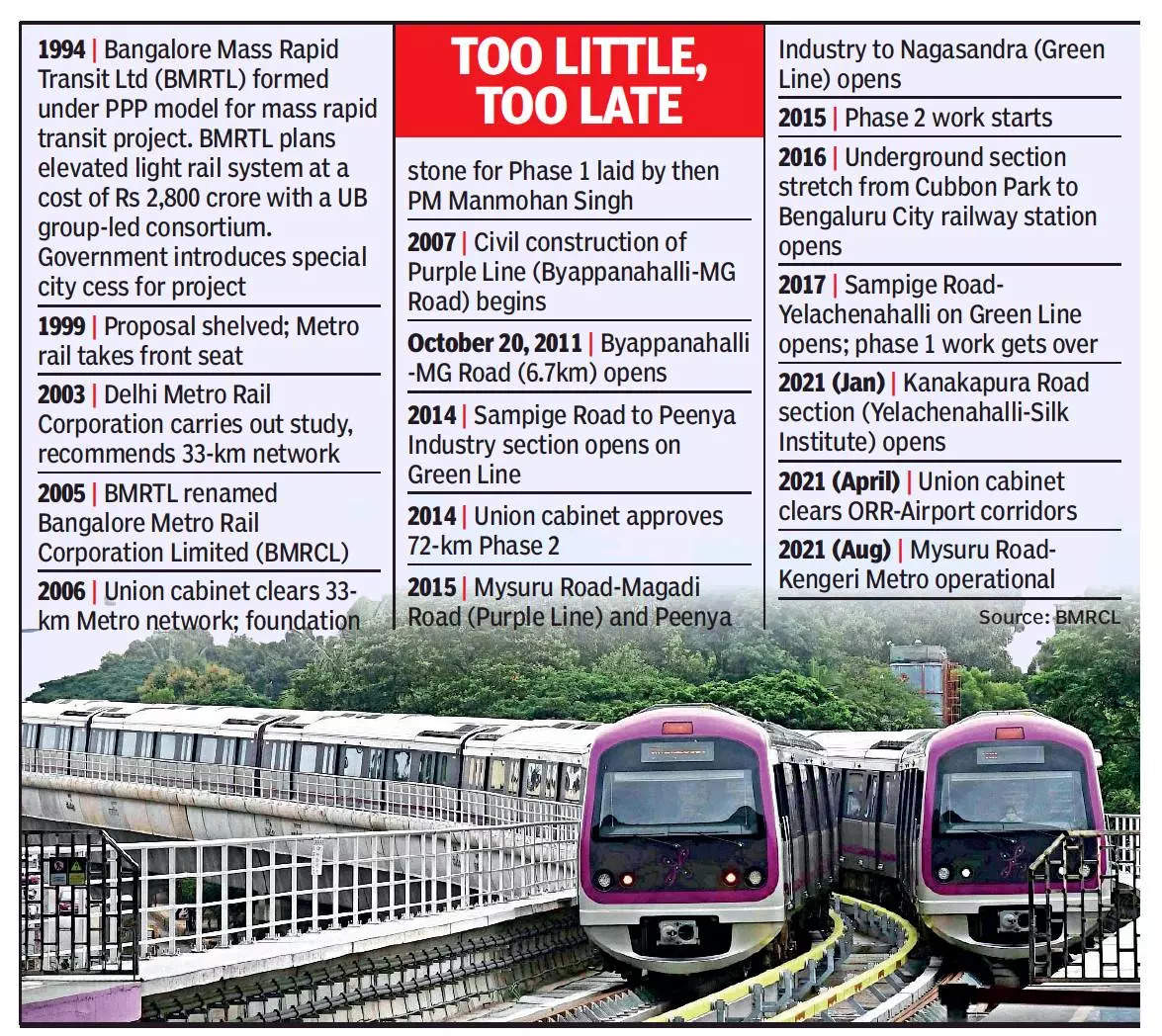At present, only two corridors: Purple Line (25.6Km Byappanahalli-Kengeri) and Green Line (30Km Nagasandra-Silk Institute) are operational. This means that BMRCL could operate on an average only 5.6 km per annum in the last decade.

In contrast, metro rail systems in other cities, including those introduced much later, are expanding at a much faster rate. The Delhi Metro, which was launched in 2002, now runs a network of 349 km, growing an average of 18 km annually. While the Hyderabad Metro, which started in 2017, runs 67-km, the Chennai Metro which started in June 2015 spans 54-km.
South India’s first metro rail is also affected by delays, missed deadlines and failure to extend into the outskirts of the city. The delay in Metro work on main roads is causing huge inconvenience to commuters in the already congested city. In fact, Metro is yet to cover the choke points of Bengaluru like ORR, Electronics City, Whitefield, Hebbal, Bannerghatta Road and KIA and the work for the same is progressing at snail’s pace.
BMRCL officials said that three metro corridors: Nagasandra-BIEC, Byppanahalli-Whitefield and RV Road-Bommasandra will be operational in 2022, while Kalena Agrahara-Nagawara will be ready by 2024. While preliminary work on Silk Board-KR Puram (18 km) on ORR commenced, work order for KR Puram-KIA (36 km) section is yet to be issued. Both corridors have a deadline of 2025.
The planning for the third phase of Namma Metro has been slow. DPR is being prepared for ORR West line – 32.1 km between Kempapura and JP Nagar Phase IV, and 12.8 km – Magadi Road line (Hosahalli station to Kadabagere). There is no word on other proposed Phase 3 corridors like Whitefield-Domalur (16 km), Hoskote-Sarjapur Road-Hebbal (52 km) near Katmanallur Gate and 34 km underground corridor along the Inner Ring Road.
Activists point out that the Center had approved Phase 2 of the 72-km stretch in 2014 with a time limit of five years, but only two extensions have started operating. In fact, the cost of the Phase II project increased from Rs 27,000 crore to Rs 30,695 crore due to delays.
“Phase 2 should have been completed by 2019. The delay has resulted in massive cost overruns. BMRCL is yet to focus on multi-modal integration. It never adheres to the deadline so people don’t take it seriously. There were also delays in raising finance for the project and land acquisition, said Sanjeev Dayamannavar, a railway worker.
India’s metro man E Sreedharan had told TOI: “The general rule is that for every 1 lakh population in a developing country like India, one km of metro is necessary. On that basis, Bengaluru should have an 80-85 km metro system by now. The speed at which the network is expanding is very poor.”
However, BMRCL officials claim that land acquisition and PILs have been major hurdles. It faced challenges in land acquisition from individuals, NICE, Forest Department and Ministry of Defence. “We faced delay due to PILs against BMRCL for cutting trees. “There were also hurdles in land acquisition and timely handing over to contractors,” an official said. He said though Phase 2 was approved in 2014, the work started only in 2015-2016. There were delays in the acquisition of funds and land for the project.
While NICE dragged BMRCL to the court to acquire its land, there was a delay in obtaining permission from the forest department to set up depots at Kadugodi and Anjanapura. The financial crunch of contractors like IL&FS and Simplex Infra added to the crisis. Covid-19, the subsequent lockdown, exodus of migrant workers and lack of industrial oxygen also affected metro operations.
.